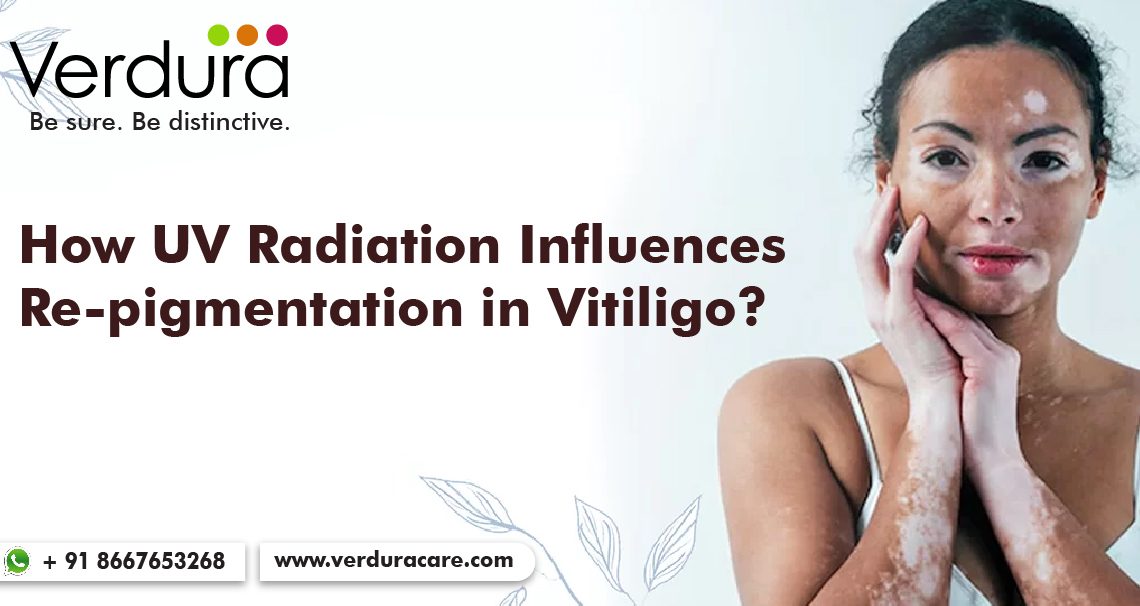How UV Radiation Influences Re-pigmentation in Vitiligo?

Do you want to know how UV radiation helps in re-pigmentation in vitiligo continue reading to know more………..

What is vitiligo?
Vitiligo is a skin condition that affects millions of people worldwide, characterized by the loss of melanin pigmentation in certain areas of the skin. This loss of pigmentation can be socially and psychologically distressing, and many people with vitiligo seek treatments to restore pigmentation to their skin.
What are the types of Vitiligo?
Generalized vitiligo– The most common type which appears all over the body.
Segmental vitiligo– affects only one side of the body and typically stops progressing after a year or two.
Focal vitiligo is characterized by depigmentation in a single spot that does not spread to other areas.
Trichome vitiligo is a unique type in which various degrees of discoloration can be seen, with a robust depigmented area followed by a lighter zone and then the natural skin tone.
Universal vitiligo is a rare form in which at least 80% of the body surface is affected.
Acrofacial vitiligo on the other hand, affects the skin around body openings, such as the eyes, nose, ears, hands, and face.
Risk factors of vitiligo:
Some of the risk factors for vitiligo include having a family history of the condition, having another autoimmune disorder, experiencing sunburn or other skin trauma, and having a melanoma or other type of skin cancer.
Complications of vitiligo:
While vitiligo is not harmful, it can have a significant impact on a person’s self-esteem and quality of life. People with vitiligo may experience social stigma, discrimination, and psychological distress.
Symptoms of vitiligo:
The primary symptom of vitiligo is the appearance of white patches on the skin, which may be accompanied by premature graying of hair on the scalp, beard, eyebrows, or eyelashes. These patches may appear on any part of the body, including the face, hands, feet, arms, and legs. The patches are usually more noticeable in people with darker skin tones.

Treatment options for vitiligo:
There is no cure for vitiligo, but there are several treatment options available that can help reduce the appearance of white patches on the skin.
Among many treatment modalities available for use in vitiligo, those using light therapy, and in particular ultraviolet (UV) light, are some of the most effective treatments. UV-based therapy includes phototherapy (narrowband UVB), photo chemotherapy (psoralens with UVA), and targeted phototherapy (excimer laser and excimer lamp). In this blog post, we’ll explore the science behind how UV radiation influences re-pigmentation in vitiligo.
UV RADIATION & VITILIGO
Ultra Violet (UV) radiation, which is a type of electromagnetic radiation, can be classified into three different types: UVA, UVB, and UVC. UVC is filtered out by the ozone layer, so it doesn’t reach the earth’s surface. UVA and UVB, however, can both penetrate the skin, and they play different roles in the repigmentation of vitiligo.
UVA radiation is able to penetrate deeper into the skin than UVB radiation. It has been shown to stimulate the activity of melanocytes, the cells that produce melanin, in both normal skin and vitiligo-affected skin. UVA radiation can also activate a process called photo oxidation, which leads to the production of free radicals that can help to stimulate melanocyte activity.
UVB radiation, on the other hand, is not able to penetrate as deeply into the skin as UVA radiation. It primarily affects the outer layers of the skin. UVB radiation has been shown to be more effective than UVA radiation in inducing re-pigmentation in vitiligo. It does this by directly stimulating the melanocytes to produce more melanin. UVB radiation also has an immunomodulatory effect, which means that it can help to regulate the immune system’s response to melanocytes.
Both UVA and UVB radiation can be used to treat vitiligo, and there are different ways to deliver these types of radiation to the skin. One way is through the use of a light box, which emits UVA or UVB radiation to the skin. Another way is through the use of topical psoralen, a drug that sensitizes the skin to UVA radiation. This is known as PUVA therapy.

What is PUVA therapy?
PUVA is the acronym for Psoralen + ultraviolet light A. PUVA is a type of phototherapy. It was first introduced in 1974 by Parish and has been used for the treatment of psoriasis and widespread recalcitrant vitiligo in adults. PUVA has been shown to be effective, but has several limitations such as the potential for nausea and vomiting, the need for ocular and skin photo protection, and the risk of severe and painful blisters.
Medications: Topical corticosteroids, calcineurin inhibitors, and other medications can be used to reduce inflammation and promote repigmentation.
Surgery: Skin grafting, blister grafting, and micropigmentation are surgical options that can be used to restore pigmentation to the affected areas.
Verdura mela pro the best vitiligo treatment cream is a natural psoralen that acts as a ‘step up transformer’ to entrap the goodness of sun light and UV radiation to augment the success of Vitiligo and Psoriasis treatments. It can be used in SUN / PUVA therapy as it Increases the susceptibility of skin to U.V rays and Kindles genetic memory of the skin to produce melanin in Vitiligo and is Proven to be hypoallergenic and safe for long term use (Skin irritation study in human volunteers)
UV radiation plays a key role in the re-pigmentation of vitiligo. UVA radiation stimulates melanocyte activity through photo oxidation, while UVB radiation directly stimulates melanocytes to produce more melanin. Both types of radiation can be used to treat vitiligo, and there are different ways to deliver them to the skin. If you have vitiligo and are considering UV radiation therapy, it’s important to discuss the risks and benefits with your dermatologist to determine if it’s the right treatment for you.
